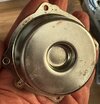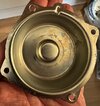So all over the bike there are these gold-ish colored steel parts. They are zinc plated and then colored with potassium chromate both of which help reduce chances of corrosion. However on older bikes, wear caused by vibrations, friction, and debris can cause this layer to wear thin or off completely in some places. On my 2001 ST1100 it’s very obvious on the tops of the vacuum diaphragms where they have got spots of rust forming
The “proper” thing to do is have the parts sent for re-plating. Where they will be cleaned, then blasted, then cleaned again, then baked to de-gas, then etched, then plated via electrolysis, rinsed, then colored with potassium chromate. It’s not a terribly long process and if I had an immense amount of parts to do I would be tempted to try my hand at home.
But it’s really only one bike and the costs of having it done are way cheaper then fitting-out in kit for a specialized process
Or…
What else could one do? There is cold-zinc plating in the form of a grey-ish spray paint. Even a paint color that is supposed to emulate the look. The one with actual zinc provides some help, but the cosmetic stuff seems to just be a bunch of foo-foo fluff.
What else could one do to protect these parts?
I was thinking spray-paint the exterior, giving it a look similar to the Harley CV40… That will address the rusting on the outside, inside is another story. These parts can come in contact with the vacuum diaphragm, which is a sensitive rubber. To my knowledge there is no other replacement to this part. They have made what they made, no more. When the spares and gently used supplies run out our bikes will stop running.
So what can be used inside? I would worry about actual paint flaking off and impacting the rubber. So something else then, DuPont makes a dry spray lubricant. It supposedly bonds with the surface. In theory this could provide protection without impacting the rubber. DuPont also makes a silicone spray with PTFE, this might also work but it would be a “moist” surface that could attract more debris and corrosion.
I was thinking about using the CRC dry moly spray lube or graphite spray. I’m not sure how much that will prevent corrosion, but it will not stick to the rubber material and moisture should also be resisted. If it’s dry it’s not going to rust.
What do all of you do? What is the strategy you all use?
The “proper” thing to do is have the parts sent for re-plating. Where they will be cleaned, then blasted, then cleaned again, then baked to de-gas, then etched, then plated via electrolysis, rinsed, then colored with potassium chromate. It’s not a terribly long process and if I had an immense amount of parts to do I would be tempted to try my hand at home.
But it’s really only one bike and the costs of having it done are way cheaper then fitting-out in kit for a specialized process
Or…
What else could one do? There is cold-zinc plating in the form of a grey-ish spray paint. Even a paint color that is supposed to emulate the look. The one with actual zinc provides some help, but the cosmetic stuff seems to just be a bunch of foo-foo fluff.
What else could one do to protect these parts?
I was thinking spray-paint the exterior, giving it a look similar to the Harley CV40… That will address the rusting on the outside, inside is another story. These parts can come in contact with the vacuum diaphragm, which is a sensitive rubber. To my knowledge there is no other replacement to this part. They have made what they made, no more. When the spares and gently used supplies run out our bikes will stop running.
So what can be used inside? I would worry about actual paint flaking off and impacting the rubber. So something else then, DuPont makes a dry spray lubricant. It supposedly bonds with the surface. In theory this could provide protection without impacting the rubber. DuPont also makes a silicone spray with PTFE, this might also work but it would be a “moist” surface that could attract more debris and corrosion.
I was thinking about using the CRC dry moly spray lube or graphite spray. I’m not sure how much that will prevent corrosion, but it will not stick to the rubber material and moisture should also be resisted. If it’s dry it’s not going to rust.
What do all of you do? What is the strategy you all use?
Attachments
Last edited:




